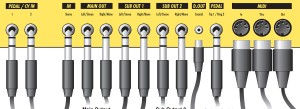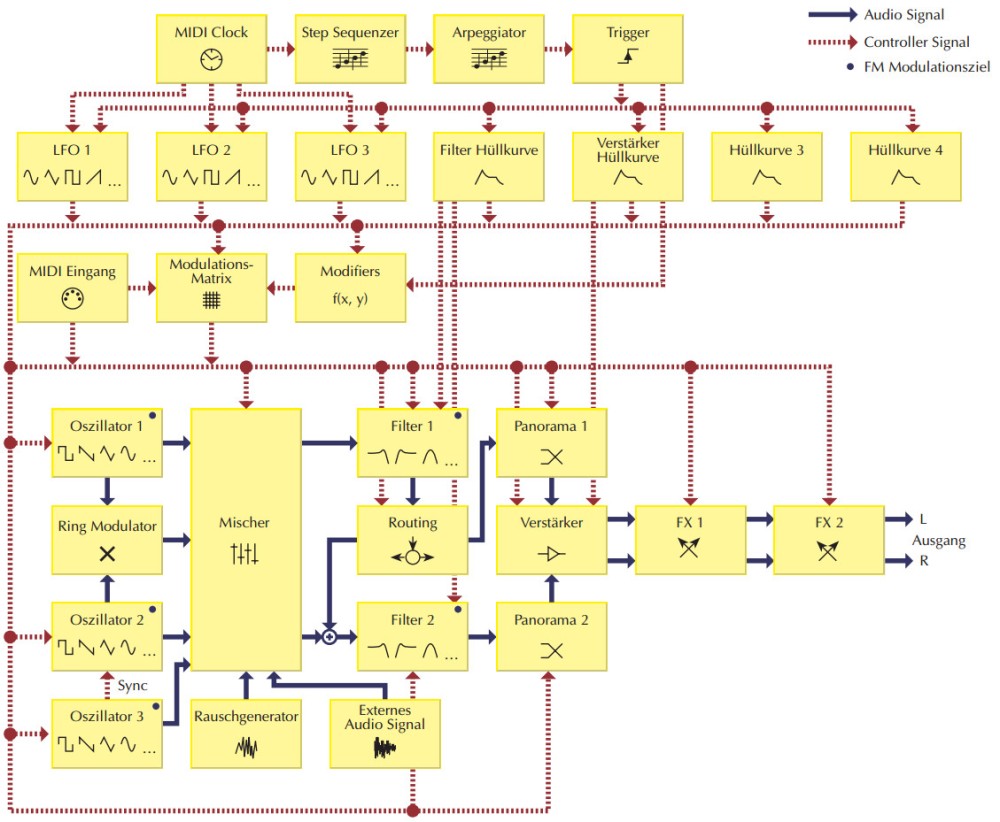There is no such thing as a perfect synthesizer – I already explained why this is at length, and this statement doesn’t come with a restricting “in my opinion”.
There can, however, be something like a best synthesizer; something that comes most close to that hypothetical ideal. Which one is best, then, is to a degree subjective.
If you’ve been following some of my ramblings, you know what I generally look for in a synth: flexibility, character, and to a lesser extent, playability and integratability.
So without much further ado: the best synth in the world is the Waldorf Q.
The Product Line and Context
Waldorf is well-known as the successor of the highly influential PPG company, and as such is perhaps most famed for continuing where PPG had stopped: wavetable synthesis. Their Microwave series, and of course the mighty Waldorf Wave focused on that and are known as the most powerful wavetable synths in history – and have passed part of their DNA to the contemporary Q. There was (and is) also analogue and analogue hybrid technology, and there was (and is) virtual analogue. Of the latter, the Q was the flagship, and the second biggest Waldorf after the Wave.
In the Q line, there was first the Q (first in bright yellow, then in a blue/grey case), then the microQ with limitations both in the sound engine and the user interface, the Q+ (black), which added analogue filters, and sometime later, the Phoenix Edition relaunch of the Q and Q+, fittingly in red. The Q and microQ were available both as keyboard synths and rackmount devices, with the later variants only available as keyboard versions (which makes sense – knobs!)

This here article is about the original Q keyboard (the yellow version).
The Synth
The Q is best described as a virtual analogue workstation synth.There’s sixteen voices (expandable to 32) shared among 16 parts of multitimbrality, with two effects and four step sequencers per part. Split and layer functionality, six outputs, connectors for two expression pedals/CV sources and two footswitches and a digital out round off the properties of a synth that is at home both on the stage and in the studio.

The most recognizable feature on this synth are however its 59 knobs, most of which are dedicated to one or two related functions, which together with lots of buttons and LEDs make this both a performer’s and a sound designer’s dream. Only the display – two lines of backlit LCD – is in its limitations true to its historical period: released in 1999, a great year that also brought us gems such as the Kurzweil K2600, the E-mu Proteus 2000 and the Access Virus B among others.
Voice Architecture
At first sight, you’ll find nothing out of the ordinary. Three oscillators plus noise source, four envelopes, three LFOs, two filters, four step sequencers, one arpeggiator and a 16-slot modulation matrix are all properties that you’ve already seen elsewhere. This also holds of course for oscillator sync options and a ring modulator, as well as for the external audio in. The combination of all of these, and the flexibility of the individual parts in this voice architecture, is what sets this synth apart. Want some examples? Osc1 and Osc2 can do wavetables, next to your standard analogue-style synth waveforms. Half of the (16) slots of your modulation matrix work at audio frequencies. And a lot of modulation options are already hardwired, meaning they don’t take up slots, and can be accessed directly with a knob. And finally, using a feature called Modifier Matrix, you can also modify the modifiers. Like by multiplying an oscillator with an envelope, this way allowing you to do full-blown three-operator FM if you’re so-inclined. The envelopes are loopable. Lots of non-standard filter types (including a convincing PPG model, and comb filters). A very flexible audio routing from the oscillators to the filters, allowing in-betweens of parallel and serial filter routing and crossfade between both filters (which, you guessed it, can be controlled by an LFO. Or a sequencer. Or release velocity. Yes, this synth both sends and receives release velocity, like most Waldorfs do).

Sound
It’s immediately clear that this synth is not a one-trick pony. With lots of options in oscillator waveforms, filter shapes and routing, and the huge modulation options, you’re obviously set to do anything that comes to mind both for analogue and non-analogue sounds. However, while being a jack of all trades of sorts, the Q avoids ending up as a master of none. In fact, I regard this as on par with the competition for your standards in leads, basses, and oldskool synth pads, and among the best for your more complex applications such as evolving pads, ambient drones, and in fact everything out of the ordinary.
It starts with the oscillators which, in addition to your standards, give you wavetables. To continue in the filter section, you have your choice of 2nd or 4th order LP/HP/BP/BR, plus comb and PPG-style lowpass filters. And the filter have a very convincing drive parameter, and differently to many other digital implementations, allow you subtle control also in the range where your virtual circuit just starts to sing. There is the complex signal routing from the stereo mixer through the filters and two panners. The choice of effects (there’s two per parts) round the sounds of truly well. And there’s a lot of tiny functions neatly hidden away, such as the Xmorph which allows you to smoothly blend between two different patches.
In Use
Everything we’ve seen so far leaves the impression that the Waldorf guys weren’t innovative at all, rather they looked through synth history, picked the best of everything, added one more just in case, and put it into an accessible user experience. This impression continues for all aspects of this synthesizers. There’s an effects section which, without being anything out of the ordinary, gives you everything you’ll typically need. There’s 5.1 surround routing (including fitting delay and reverb effects). And considering the small display by today’s and even 1999 standards (hey, even my old Wavestation has a much bigger one), they designed a workflow that is fast and intuitive.
Again, a lot of fantastic features are not visible at first sight: several tunings (including an intelligent HMT), or, one of the highlights for live use, a really tricky handling of MIDI clock, which allows you to receive, route via MIDI thru, and generate clocks rather independently and context-sensitive (e.g. dependent if you receive a MIDI clock on the input) to allow you to work in any situation without having to reconfigure. Which other synth does this?
Limitations
It can’t use samples as oscillators. Apart from, that: nothing, really. Which also means that if you combine it with a flexible sample-based workstation (such as, in my case, the Kurzweil K2600S), you can achieve sonic world domination with just two synths.
The Competition
There is none. The only thing that is similar in some aspects is DSI’s wonderful Prophet-12. It wins with even more powerful voices feature-count wise, but lacks proper wavetables and most of the Q’s workstation features. So no real competition. The Q fights in its own class, and that makes absolutely sense, because competing with it would be a problem for the competition.
What’s so great about it
From everything I described so far, it’s easy to see: this synth didn’t bring a single innovation to the history of synthesizers.
The beauty lies in how the proven-in-use building blocks from all eras of synth design were put together in an architecture, and matched with a user interface, that makes it a truly enjoyable experience. It’s got lots of flexibility, yet it’s got a character all of its own. It has huge possibilities, but is surprisingly easy to use. It shines in a performer’s role, as well as in the studio. And it looks cool, especially if you get the original yellow one.
Where I used it
It works well both in the studio and live. It’s very flexible. And fun to use. No wonder I used it a lot ever since I got it back early in 2004.
Some examples? The arp synth on Lazer. That “digital synth percussion” and the lead on Solid State. The angry sound on Yivli Minare. One of the ten synths of Die Kraft der Wassersuppe. A lot of times during An Ambient Manifold. I could go on…
This is a great synth. The best in the world – in my opinion.
Buyer’s Advice
Due to this thing being what it is, used prices are still high and you’re easily bound to pay above 1000 bucks for a good-condition Q.
Firstly, I’d steer clear of the microQ. Even as it looks competitive on paper, comparisons have shown that one area where cuts were made are the algorithms, most importantly the filters and the effects. It doesn’t even have the PPG algorithm, and the filters just don’t sing that well.
For the different variants of the full-blown Q, the first question is if the addition of sixteen analogue low-pass filters is that important for you. If yes, your only choice is the Q+, which comes at a price. Considering the consistently high quality of the filter models in this synth and the fact that you’ll still end up with digital oscillators and amplifiers on the Q+, the use of it seems at best debatable to me.
The advantage of the Phoenix Edition is the flexible DSP resource allocation, giving you up to 100 voices for simple patches. If that is really necessary is up to you. And the same goes for the expansion to 32 voices for the original Q.
I would choose the keyboard version over the rack version any day, simply because it’s got so many knobs, and this is one of the aspects which make this synth so much fun. Plus, the keyboard is a really good one – I’ve never played another synth where aftertouch could be played so expressivle before.
Finally, the Q has a reliability issue, and it relates to the rotary encoders. Which is bad, because there’s so many of them. Cleaning helps, to a degree, and for some time. Reportedly, the Phoenix Edition has addressed this in part, and some report that there has been a change during the original run as well. Still, if you get a non-Phoenix Q, test that the encoders still work, at least mostly. If the previous owner has replaced them already, then that’s a plus, otherwise prepare yourself to do this yourself after some time.
One thought on “The Best Synth in the World (in my opinion)”